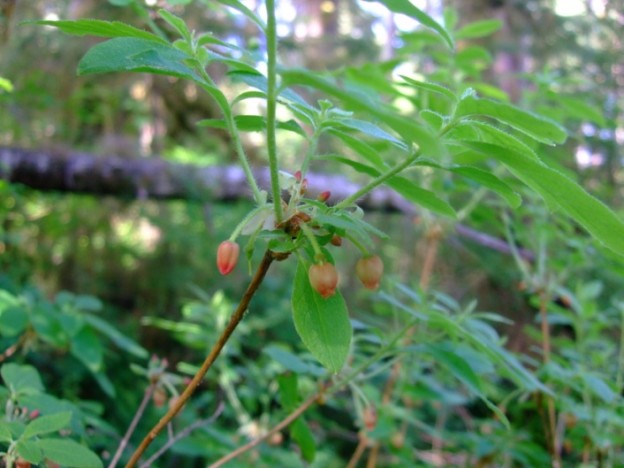Related ericads often found together in subalpine areas:
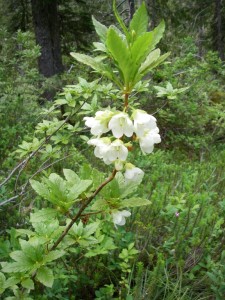 Cascade Azalea, Rhododendron albiflorum Hook. Also known as White-flowered (the meaning of albiflorum) Rhododendron, it has showy cup-shaped flowers. The upper surface of the leaves are covered with fine rusty hairs, the underside has white hairs only on the mid vein. Unfortunately, horticulturists have had very little success taming this subalpine gem in a cultivated garden. People continue to try; but for now only hikers can enjoy this beautiful rhododendron!
Cascade Azalea, Rhododendron albiflorum Hook. Also known as White-flowered (the meaning of albiflorum) Rhododendron, it has showy cup-shaped flowers. The upper surface of the leaves are covered with fine rusty hairs, the underside has white hairs only on the mid vein. Unfortunately, horticulturists have had very little success taming this subalpine gem in a cultivated garden. People continue to try; but for now only hikers can enjoy this beautiful rhododendron!
Links:

Distribution of Cascade Azalea from USDA Plants Database
Consortium of Pacific Northwest Herbaria
WTU Herbarium Image Collection, Plants of Washington, Burke Museum
E-Flora BC, Electronic Atlas of the Flora of British Columbia
Ladybird Johnson Wildflower Center
Native American Ethnobotany, University of Michigan, Dearborn
Copperbush, Elliottia pyroliflora (Bong.) S.W. Brim & P.F. Stevens. Previously known as Cladothamnus pyroliflorus, Copperbush has been reclassified into the genus Elliottia, due to its more recently discovered relationship to Georgia Plume, E. racemosa. Cladothamnus means branching bush, pyroliflora refers to flowers that resemble pyrola (wintergreen) flowers. Copperbush refers to either its copper-colored flowers or its coppery peeling bark. Its leaves are hairless, covered in a waxy powder. Copperbush often grows along the edges of streambanks and bogs. It can be propagated by seed. Although some references state that it is “easily found in nurseries,” I have never seen it and can only find a couple of nurseries in BC that list it in their inventories.
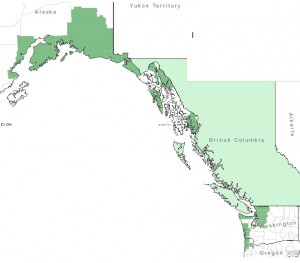
Distribution of Copperbush from USDA Plants Database
Links:
Consortium of Pacific Northwest Herbaria
WTU Herbarium Image Collection, Plants of Washington, Burke Museum
E-Flora BC, Electronic Atlas of the Flora of British Columbia
Ladybird Johnson Wildflower Center
Native American Ethnobotany, University of Michigan, Dearborn
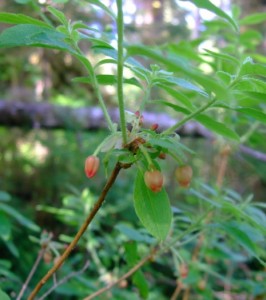 *False Azalea, Menziesia ferruginea Sm. False Azalea is also known as Fool’s Huckleberry, Mock Azalea, Rusty Menziesia, Rusty Leaf or other similar combinations. It is named after botanist and explorer, Archibald Menzies. Ferruginea (ferrous=iron) refers to the rusty-colored, glandular hairs on the leaves and twigs (although they are sometimes white). The bluish-green leaves are sticky with the mid-vein protruding slightly at the tip. They turn brilliant orange-red in the fall. The bell-shaped flowers are similar to huckleberry flowers, but are usually salmon-colored. It produces dry, 4-valved capsules instead of berries. Unlike, the previous two species, False Azalea is easier to grow and find in native plant nurseries. Many now lump it in with Rhododendrons, synonym: Rhododendron menziesii.
*False Azalea, Menziesia ferruginea Sm. False Azalea is also known as Fool’s Huckleberry, Mock Azalea, Rusty Menziesia, Rusty Leaf or other similar combinations. It is named after botanist and explorer, Archibald Menzies. Ferruginea (ferrous=iron) refers to the rusty-colored, glandular hairs on the leaves and twigs (although they are sometimes white). The bluish-green leaves are sticky with the mid-vein protruding slightly at the tip. They turn brilliant orange-red in the fall. The bell-shaped flowers are similar to huckleberry flowers, but are usually salmon-colored. It produces dry, 4-valved capsules instead of berries. Unlike, the previous two species, False Azalea is easier to grow and find in native plant nurseries. Many now lump it in with Rhododendrons, synonym: Rhododendron menziesii.
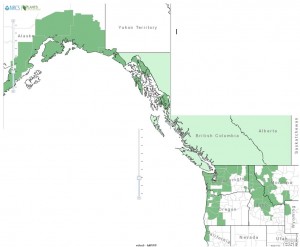
Distribution of False Azalea from USDA Plants Database
Links:
Consortium of Pacific Northwest Herbaria
WTU Herbarium Image Collection, Plants of Washington, Burke Museum
E-Flora BC, Electronic Atlas of the Flora of British Columbia
Jepson Eflora, University of California
Ladybird Johnson Wildflower Center
USDA Forest Service-Fire Effects Information System
Native Plants Network, Propagation Protocol Database
Native American Ethnobotany, University of Michigan, Dearborn

